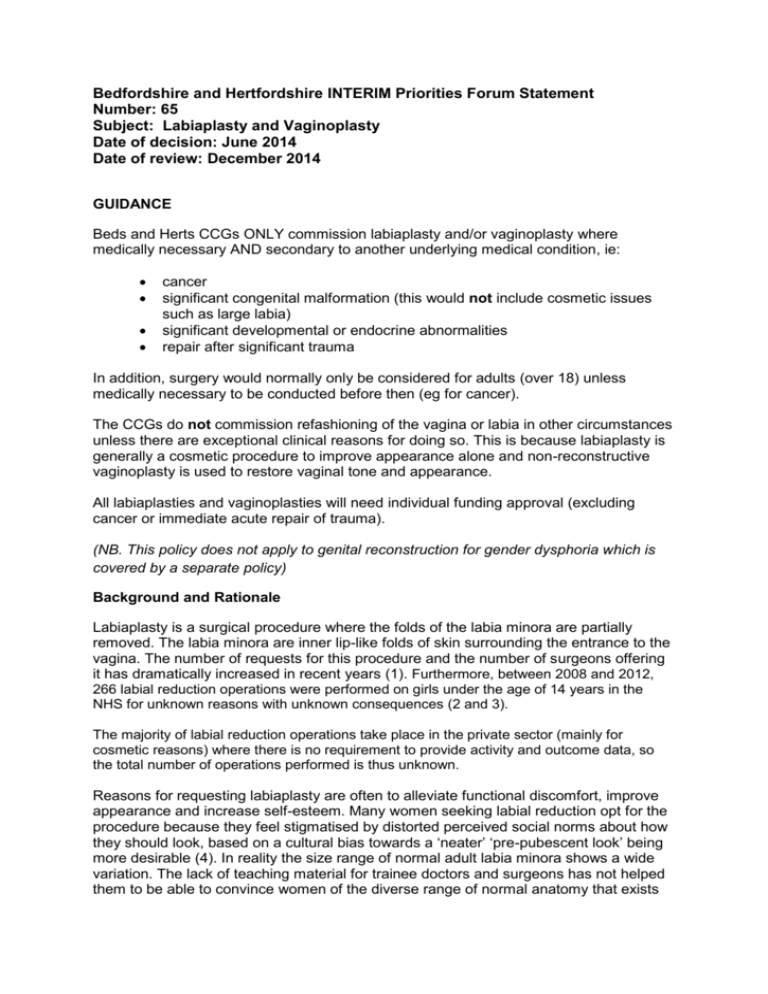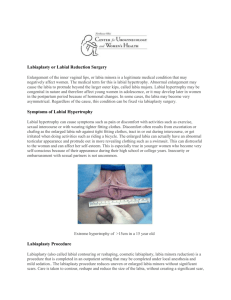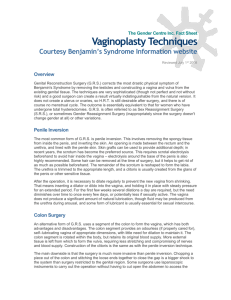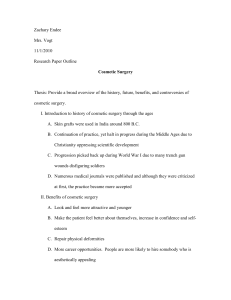Bedfordshire and Hertfordshire INTERIM Priorities Forum Statement
advertisement

Bedfordshire and Hertfordshire INTERIM Priorities Forum Statement Number: 65 Subject: Labiaplasty and Vaginoplasty Date of decision: June 2014 Date of review: December 2014 GUIDANCE Beds and Herts CCGs ONLY commission labiaplasty and/or vaginoplasty where medically necessary AND secondary to another underlying medical condition, ie: cancer significant congenital malformation (this would not include cosmetic issues such as large labia) significant developmental or endocrine abnormalities repair after significant trauma In addition, surgery would normally only be considered for adults (over 18) unless medically necessary to be conducted before then (eg for cancer). The CCGs do not commission refashioning of the vagina or labia in other circumstances unless there are exceptional clinical reasons for doing so. This is because labiaplasty is generally a cosmetic procedure to improve appearance alone and non-reconstructive vaginoplasty is used to restore vaginal tone and appearance. All labiaplasties and vaginoplasties will need individual funding approval (excluding cancer or immediate acute repair of trauma). (NB. This policy does not apply to genital reconstruction for gender dysphoria which is covered by a separate policy) Background and Rationale Labiaplasty is a surgical procedure where the folds of the labia minora are partially removed. The labia minora are inner lip-like folds of skin surrounding the entrance to the vagina. The number of requests for this procedure and the number of surgeons offering it has dramatically increased in recent years (1). Furthermore, between 2008 and 2012, 266 labial reduction operations were performed on girls under the age of 14 years in the NHS for unknown reasons with unknown consequences (2 and 3). The majority of labial reduction operations take place in the private sector (mainly for cosmetic reasons) where there is no requirement to provide activity and outcome data, so the total number of operations performed is thus unknown. Reasons for requesting labiaplasty are often to alleviate functional discomfort, improve appearance and increase self-esteem. Many women seeking labial reduction opt for the procedure because they feel stigmatised by distorted perceived social norms about how they should look, based on a cultural bias towards a ‘neater’ ‘pre-pubescent look’ being more desirable (4). In reality the size range of normal adult labia minora shows a wide variation. The lack of teaching material for trainee doctors and surgeons has not helped them to be able to convince women of the diverse range of normal anatomy that exists (5). Women may also have unrealistic expectations of the surgery, and be disappointed with the outcome which may include adverse effects like scarring and loss of sensitivity (6). Surgery for labia minora is being marketed as an effective treatment for women's complaints, such as recurrent urinary tract infections (UTIs), or to enhance sexual functioning, but as there is a lack of high quality evidence for a beneficial effect, it should be considered as medically non-essential surgery and thus not routinely commissioned. Indeed, in one large multicentre study (7), it was noted that although over 90% of patients were satisfied with the results of their surgery in the short term, it was stated that sexual dysfunction before surgery and enhancement after surgery is highly subjective and difficult to quantify. Some case series also point to re-operation rates following labiaplasty of up to 7% for reasons such wound dehiscence, infection and dissatisfaction with appearance (8). None of the studies found in a literature review looked at the potential for long term obstetric complications after such surgery. As with any surgical procedure, labiaplasty carries short-term risks of bleeding and wound infection. However, there are no data on the potential physical and psychological risks in the medium and long term. Long-term damage to sensitivity and sexual function may also occur after labiaplasty, as surgery will disrupt nerve supply with consequences for sensitivity. In a 2013 paper (3) on the Ethics of female genital cosmetic surgery (FGCS) , the Royal Collage of Gynaecology states: “Clinicians have a duty of care to provide these women with accurate information on the diversity of morphology and appearance of the female genitalia and to suggest simple measures to relieve genital discomfort where no pathology can be identified. The importance of education, support and advice should be at the heart of clinical practice, with sympathetic appreciation of the female body insecurities that are rife in western society. The presentation of female genital cosmetic surgery as an unproblematic lifestyle choice is undesirable because it misleads women as to the need for and the efficacy of such surgical techniques.” The RCOG recommends in this paper (3) that FGCS should not be undertaken within the NHS unless it is medically indicated, and (owing to anatomical development during puberty) should not normally be offered to individuals below 18 years of age. The ethics paper (3) also emphasises how important it is to distinguish between “situations in which a woman’s labia give rise to functional problems that provide therapeutic grounds for the procedure, and situations in which there are no such functional problems and a woman’s motivation for asking for labiaplasty is primarily a concern about her genital appearance.” A 2011 editorial (9) states that women and girls who are concerned about any part of their genitals should have an examination, and where the genitalia are healthy and normal, this should be made “unambiguously clear” to the women and girls. In this respect, GPs and other front-line staff have a crucial role in educating and reassuring women and girls. References: 1. Lloyd J, Crouch NS, Minto CL, Creighton SM. (2005) Female genital appearance: ‘normality’ ‘unfolds’. BJOG - An International Journal of Obstetrics and Gynaecology 2005; 112:643-646. 2. British Society for Paediatric & Adolescent Gynaecology (BritSPAG). Position Statement: Labial Reduction Surgery (Labiaplasty) on Adolescents (October 2013) 3. RCOG Ethics Committee (2013) Ethical considerations in relation to female genital cosmetic surgery (FGCS) 4. Moran C, Lee C. What’s normal? Influencing women’s perceptions of normal genitalia: an experiment involving exposure to modified and non-modified images. BJOG 2013; DOI: 10.1111/1471-0528.12578. 5. BBC Radio 4 Woman’s Hour (18/11/13) Labiaplasty – NHS restrictions and interview with Kaye Wellings, Professor of Sexual and Reproductive Health http://www.bbc.co.uk/programmes/p00wr7q8 (accessed 19/11/13) 6. Bramwell R, Morland C, Garden AS (2007). Expectations and experience of labial reduction: a qualitative study. BJOG An International Journal of Obstetrics and Gynaecology 2007; 114:1493-1499. 7. Goodman MP, Placik OJ, Benson RH et al, (2010) A large multicentre outcome study of female genital plastic surgery. Journal of Sexual Medicine 2010; 7:1565-77. 8. Liao LM, Michala L, Creighton SM. (2010) Labial surgery for well women: a review of the literature. BJOG An international Journal of Obstetrics and Gynaecology 2010; 117: 20-25. 9. Editorial. Female genital cosmetic surgery: a new dilemma for GPs. British Journal of General Practice, January 2011 p7-8 10. Lih Mei Liao and Sarah M Creighton. Requests for cosmetic genitoplasty: how should healthcare providers respond? BMJ | 26 May 2007 | Volume 334 p 1090 -1092. Human Rights and Equality Legislation has been considered in the formation of this guidance.










